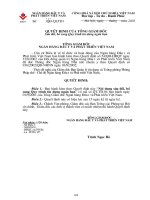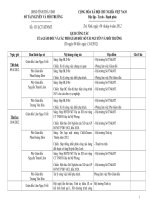UBI-GM-Presentation10.050112-wld org. doc
Bạn đang xem bản rút gọn của tài liệu. Xem và tải ngay bản đầy đủ của tài liệu tại đây (2.35 MB, 49 trang )
Multinational Market Regions and Market Groups
Chapter 10
McGraw-Hill/Irwin © 2005 The McGraw-Hill Companies, Inc. All rights reserved.
PowerPoint presentation prepared by:
Alfred Lowey-Ball
Associate Professor of Marketing
UBI-United Business Institutes
Brussels, Belgium
Chapter Learning Objectives
1. The reasons for economic union
1. The reasons for economic union
2. Patterns of international cooperation
2. Patterns of international cooperation
3. The evolution of the European Community to
the European Union
3. The evolution of the European Community to
the European Union
4. Strategic implications for marketing in Europe
4. Strategic implications for marketing in Europe
Chapter Learning Objectives
5. Evolving patterns of trade as Eastern Europe
and the former Soviet states embrace the
free-market system
5. Evolving patterns of trade as Eastern Europe
and the former Soviet states embrace the
free-market system
6. The trade linkage of NAFTA and South
America and its regional effects
6. The trade linkage of NAFTA and South
America and its regional effects
7. The development of trade within the Asia-
Pacific Rim
7. The development of trade within the Asia-
Pacific Rim
Introduction
•
The evolution and growth of multinational market regions—
those groups of countries that seek mutual economic benefit
from reducing interregional trade and tariff barriers—are the
most important global trends today
•
Organizational form varies widely among market regions, but
the universal goal of multinational cooperation is economic
benefit for the participants
•
Political and social benefits sometimes accrue, but the dominant
motive for affiliation is economic.
•
The world is awash in economic cooperative agreements as
countries look for economic alliances to expand access to free
markets.
Traits of Successful Economic Unions
1. Economic Compatibility (similar
economic systems)
2. Political Compatibility (similar
political systems)
3. Cultural Compatibility
4. Geographic factors
5. Weakness in some must be balanced
by strengths in others
Patterns of Multinational Cooperation
1. Regional Cooperation Groups
2. Free Trade Areas
3. Customs Unions
4. Common Markets and
Economic Unions
5. Political Unions
•
There are five fundamental groupings for regional economic
integration as follows:
•
There are five fundamental groupings for regional economic
integration as follows:
•
Viewed on a spectrum, each requires greater levels of
cooperation among member nations and include:
•
Viewed on a spectrum, each requires greater levels of
cooperation among member nations and include:
Regional Cooperation Groups
•
A group of countries that have
agreed to participate in basic
industries beneficial to each or
jointly develop joint ventures
that benefit both countries,
e.g., Colombia and Venezuela
built a hydroelectric dam on
the Orinico river which both
share
Free Trade Areas
•
Examples of Free Trade
Areas: NAFTA, and
European Free Trade
Area (EFTA) between
Iceland, Liechtenstein,
Norway, and Switzerland
•
A group of countries that have agreed to reduce drastically (but
not eliminate) all trade barriers such as customs duties and non-
tariff barriers (standards)
•
A group of countries that have agreed to reduce drastically (but
not eliminate) all trade barriers such as customs duties and non-
tariff barriers (standards)
•
Member countries can have different trade policies for other
external countries
•
Member countries can have different trade policies for other
external countries
Customs Unions
•
Examples of Customs Unions:
East African Customs Union
between Ethiopia, Kenya, Sudan,
Tanzania, Uganda, and Zambia
•
In addition to drastically reducing trade barriers from FTA
identified previously, a group of countries that have agreed to
eliminate customs duties levied among member countries
•
In addition to drastically reducing trade barriers from FTA
identified previously, a group of countries that have agreed to
eliminate customs duties levied among member countries
•
Also establishes common external barriers like imposing a
common tariff on goods imported from countries out of the
association.
•
Also establishes common external barriers like imposing a
common tariff on goods imported from countries out of the
association.
Common Markets
•
Latin America boasts three common markets: the Central
American Common Market (CACM), the Andean
Common Market, and the Southern Cone Common Market
(MERCOSUR).
•
The three have roughly similar goals and seek eventual full
economic integration.
•
In addition to drastically reducing trade barriers, and eliminating customs
duties levied from FTA and Customs Unions identified previously, a
common market is a group of countries that allow:
the free flow of capital and labor (engineers, doctors, and lawyers can
work without recertification) among members
a common currency
a common central bank; and
common policies on transportation, agriculture, social services, welfare,
and taxes
•
In addition to drastically reducing trade barriers, and eliminating customs
duties levied from FTA and Customs Unions identified previously, a
common market is a group of countries that allow:
the free flow of capital and labor (engineers, doctors, and lawyers can
work without recertification) among members
a common currency
a common central bank; and
common policies on transportation, agriculture, social services, welfare,
and taxes
Political Unions
•
Examples of Political Unions:
COMECON (Council for
Mutual Economic Assistance),
and U.S.S.R., but it no longer
exists
•
The highest level of cooperation among member countries
•
The highest level of cooperation among member countries
•
A group of countries that have agreed to complete political and
economic integration and cooperation among members
•
A group of countries that have agreed to complete political and
economic integration and cooperation among members
Global Markets and Multinational Market Groups
1. The globalization of markets
2. The restructuring of Eastern Europe into independent
market-driven economies
3. The dissolution of the Soviet Union into independent
states and
4. The worldwide trend toward economic cooperation
•
Many Multinational Market Groups have emerged due to
recent trends that include:
•
Many Multinational Market Groups have emerged due to
recent trends that include:
•
Various examples of Multinational Market Groups are
provided next
•
Various examples of Multinational Market Groups are
provided next
Canada
Canada
United States
United States
Mexico
Mexico
NAFTA Rules of Origin
Tariff shift rule
Tariff shift rule
•
Non-NAFTA imports undergo sufficient
manufacture or processing to become products that
can qualify under a different tariff classification.
•
Non-NAFTA imports undergo sufficient
manufacture or processing to become products that
can qualify under a different tariff classification.
Value-content rule
Value-content rule
•
A set percentage of the value of the good must be
North American (usually coupled with a tariff
classification shift requirement). Some goods are
subject to the value-content rule only when they
fail to pass the tariff classification test because of
non-NAFTA inputs.
•
A set percentage of the value of the good must be
North American (usually coupled with a tariff
classification shift requirement). Some goods are
subject to the value-content rule only when they
fail to pass the tariff classification test because of
non-NAFTA inputs.
Economic Cooperation Organization (ECO)
Pakistan
Pakistan
Iran
Iran
Turkey
Turkey
Azerbaijan
Azerbaijan
Turkmenistan
Turkmenistan
Uzbekistan
Uzbekistan
Central European Free-Trade Area (CEFTA)
Poland
Poland
Hungary
Hungary
Slovakia
Slovakia
Czech Republic
Czech Republic
Slovenia
Slovenia
Romania
Romania









